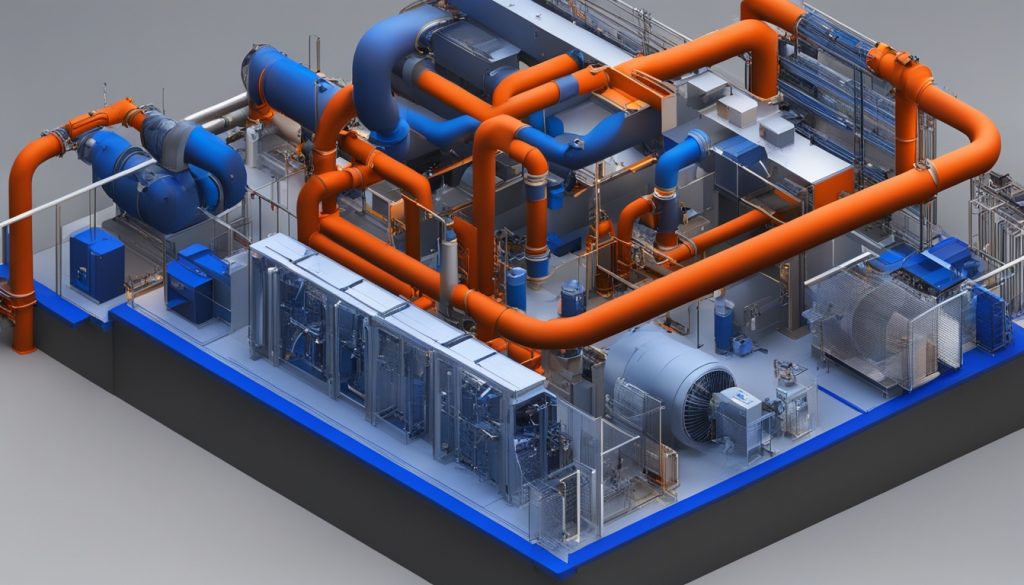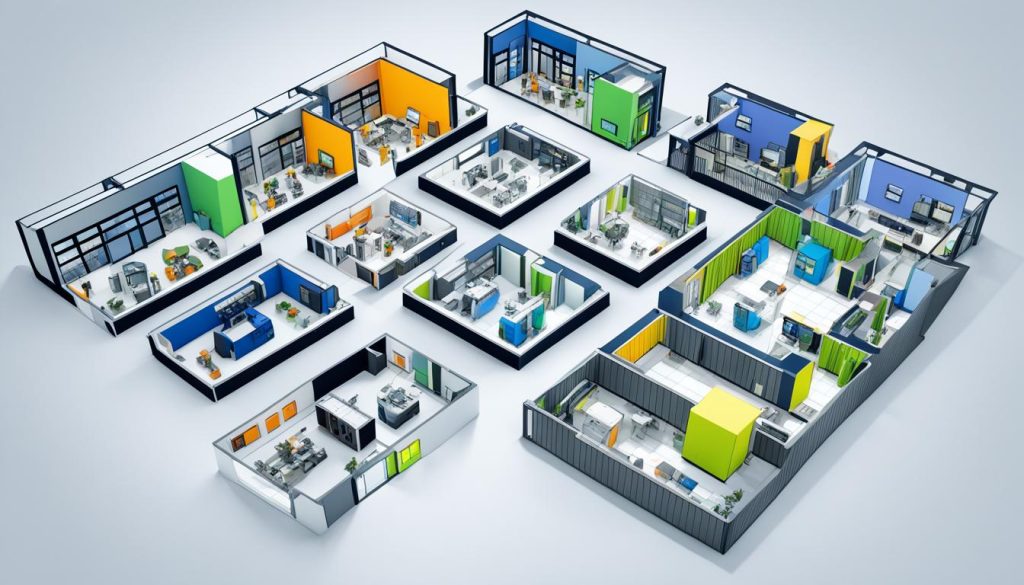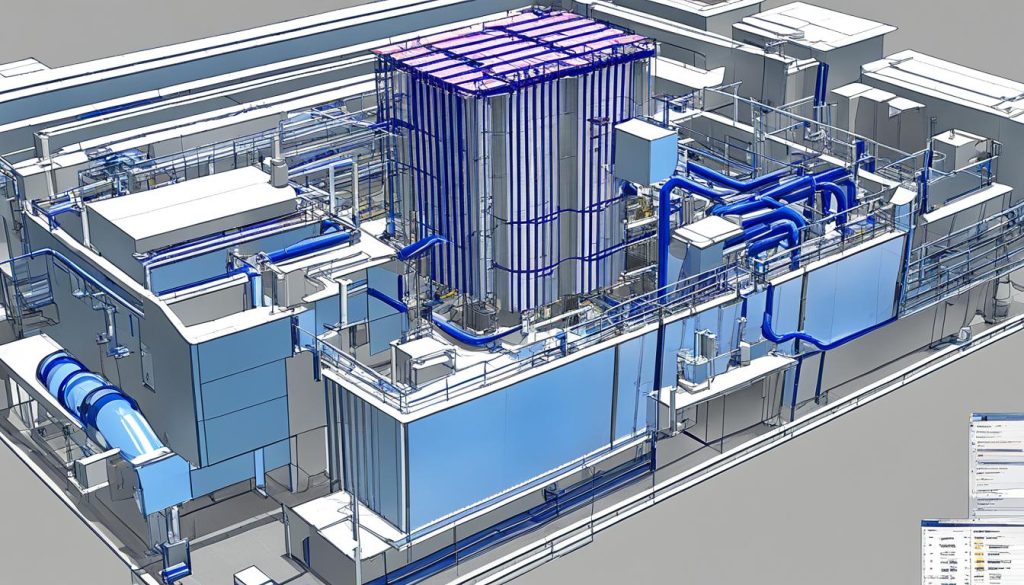Looking for the best HVAC CAD software guide? This article helps you with overviews and reviews. It includes everything from top software options to specific features. For instance, Right-CAD® offers tools like Right-J® and Right-CommLoad®. These tools help you from load calculations to drawing and cost guesses. Right-CAD® uses advanced 2D/3D visuals, auto-sizing, and templates to meet your needs. It shows how HVAC CAD software improves the way you work.
Curious how these tools change your job? Great HVAC design software makes your work more accurate and efficient. It can totally change how you design HVAC systems. Keep reading to see how HVAC CAD software is a must for pros today.
Key Takeaways
- HVAC CAD software aids in every aspect of design and implementation.
- Right-CAD® integrates modules like Right-J® for comprehensive workflow management.
- Advanced features include 2D/3D visualization and auto-sizing functions.
- This software enhances precision, efficiency, and compliance with industry standards.
- Seamless transition from load calculations to system design and operational cost estimation.
- Customizable templates adapt to various project needs.
- Modern HVAC CAD software is indispensable for professionals in the sector.
Introduction to HVAC CAD Software
HVAC CAD software helps designers and engineers make detailed drawings of HVAC systems. It shows ducts, pipes, and where equipment goes. This is key for HVAC design work today. It lets professionals plan and build HVAC systems more efficiently with fewer mistakes.
What is HVAC CAD Software?
HVAC CAD software is for drawing and setting up HVAC systems better. Professionals use it to make accurate plans. This makes sure the HVAC work meets safety and efficiency rules. The software includes tools for drawing, modeling, and checking how the system will work.
Importance of HVAC CAD Software in Modern Designs
Top HVAC CAD software is very important in today’s HVAC design work. It lets designers be very precise in their plans. This is key for making energy-efficient and green systems. It’s among the best CAD programs, helping to lower mistakes, save time, and reach top-quality results.
Benefits of Using HVAC CAD Software
HVAC CAD software is a game-changer in how HVAC projects are designed and carried out. It brings a lot of good changes, from making things more accurate to improving how fast you can finish a project and work together with others.
Enhanced Accuracy
This software is spot-on when it comes to getting things right. It makes sure every design detail is perfect and follows the rules. This means less chance of making mistakes and better HVAC systems that do what they should do.
Improved Efficiency
Using this software also makes everything run smoother and faster. It has tools that do a lot of the hard work for you, like figuring out the size of your system or how the pipes should be laid out. This saves you a ton of time and lets you put more effort into parts of the job that need your attention.

Collaboration and Communication
Today’s HVAC drawing software lets everyone work together easily, no matter where they are. Lots of people can jump into the same project files at the same time. This really helps on big projects where many experts have to work together. It keeps everything moving smoothly and keeps your project on schedule.
| Feature | Benefit |
|---|---|
| Enhanced Accuracy | Ensures precise control over every design element and compliance with industry standards. |
| Improved Efficiency | Streamlines the design process through automation, reducing manual tasks and focusing on critical aspects. |
| Collaboration | Facilitates real-time collaboration among multiple users, enhancing communication and project adherence. |
Top CAD Programs for HVAC Professionals
HVAC pros have many choices in CAD programs for designing systems. These tools are crucial for creating both residential and commercial HVAC systems. They ensure accuracy and efficiency in your projects.
Right-CAD®
Right-CAD® is a top pick in the HVAC CAD software guide. It works alongside Wrightsoft modules like Right-J® and Right-CommLoad®. Right-CAD® mixes standard CAD commands with HVAC Shapes™.
This makes it really customizable. You can adjust the look, how it works, and the starting templates to fit your projects.
Features of Popular CAD Programs
When you look at CAD software for HVAC use, some features stand out. Besides Right-CAD®, you’ll find tools that can do things like:
- Hotlink™ Technology: Helps with real-time updates and sharing info across platforms.
- Customizable Templates: Lets you adjust templates for your project’s needs.
- Extended File Compatibility: Makes it easy to use with other software and systems.
Checking out these features in HVAC software reviews can help you decide. It makes sure you pick a tool that fits what you do.
| CAD Program | Key Features |
|---|---|
| Right-CAD® | Integration with Wrightsoft, Custom HVAC Shapes™, Hotlink™ Technology |
| AutoCAD MEP | Better BIM Workflows, Detailed HVAC Equipment Database, Drafting Automation |
| Revit | Building Info Modeling, Sizing HVAC Equipment, 3D Viewing |
| TRACE® 3D Plus | Loads, Energy Models, Detailed System Checks |
Using the best CAD programs helps HVAC experts make correct and modern designs. The HVAC CAD software guide points you in the right direction. Reading HVAC software reviews gives you more on the tools’ features and how they work, helping you choose the best one.
HVAC CAD Software Features to Consider
Choosing the right HVAC CAD software means looking at key features. These features ensure it works well with your current systems. This guide will help you decide wisely.
Integration with Other HVAC Tools
It’s vital that the software can work well with other HVAC tools. With good integration, your work will be smoother. It will blend load calculations and designs easily, making everything more accurate and quicker.
2D and 3D Visualization Capabilities
Having strong 2D and 3D tools is key for clear design plans. Pick software that lets you see different views easily. This helps spot problems early and makes sure your designs are up to standard.
Auto-Sizing and Auto-Branch Run Functions
Look for tools that can make your work faster and less prone to mistakes. Good software will automatically handle the rough parts of your designs. This includes properly sizing components and setting up duct and pipe paths without much effort.
- Integration with other HVAC tools
- 2D and 3D visualization capabilities
- Auto-sizing and auto-branch run functions
HVAC Design Software Comparison
Finding the right HVAC design software is crucial. We’ll compare Fusion 360, Solidworks, Right-CAD®, and HVAC Solution. We’ll show what they offer for designing HVAC systems.
Fusion 360 vs. Solidworks
Fusion 360 and Solidworks are top CAD choices for HVAC. Fusion 360 stands out for working in the cloud. You can work with others on different devices. It’s known for being easy to use with many design tools, such as 3D modeling.
Solidworks shines in complex mechanical designs.It’s great for those needing detailed designs and simulations. While both have good visualization tools, Solidworks is better for in-depth analysis and simulations.
Right-CAD® vs. HVAC Solution
In the HVAC design software comparison, Right-CAD® and HVAC Solution are key. Right-CAD® caters to HVAC pros with modules like Right-J®. It makes tasks from load calculations to full system designs easier. Its features for auto-sizing and templates boost accuracy and speed.
HVAC Solution allows easy creation and editing of system layouts. It helps you choose components smartly with its vast databases. For a variety of HVAC projects, it’s a flexible option. Both tools make sharing data smooth.
| Software | Unique Features | Best For |
|---|---|---|
| Fusion 360 | Cloud-based, user-friendly interface, 3D modeling | Collaborative projects, accessible from multiple devices |
| Solidworks | Advanced parametric modeling, simulation tools | Detailed mechanical design, complex components |
| Right-CAD® | HVAC-specific modules, auto-sizing, customizable templates | Professional HVAC system design, load calculations |
| HVAC Solution | Drag-and-drop, extensive equipment databases, intelligent component selection | Versatile HVAC projects, quick system layouts |
Both Right-CAD® and HVAC Solution have strong tools for HVAC work. It’s important to weigh their benefits against your project’s needs. This way, you pick the best software for your project in this HVAC design software comparison.

How to Select the Best HVAC Drafting Tools
Choosing top HVAC drafting tools is key for better work and accurate designs. Understand what makes software work well. This helps pick the best for you.

Factors to Consider
Think about a software’s fit with your current tools and its special HVAC CAD features. Make sure it has strong tools like load calculations and could work with other needed tools well.
A software that’s easy to use is important. Find one with clear directions and easy to get used to. This lets both new and skilled users learn it fast, making work smoother.
Reading reviews from trusted sources can help you choose. They tell you how good software is for use, how well it works, and its support. This info is great to know your best option.
| Key Factor | Description | Importance |
|---|---|---|
| Advanced HVAC CAD Software Features | Load calculations, energy simulations, and equipment sizing | High |
| User Interface | Intuitive navigation and clear commands | High |
| Ease of Use | Reduced learning curve for novices and experienced users | Medium |
| Cost-Effectiveness | Value for money with scalable features | Medium |
| Customer Support | Availability of comprehensive help and support documentation | High |
Focus on these key points to get the right HVAC CAD software. This will improve your work in both effectiveness and accuracy of HVAC projects.
HVAC Drawing Software Options
It’s key to pick the right HVAC drawing software options for good system designs. Many choices exist, for various needs and project sizes. You should look at top CAD programs for HVAC by their features, how they work with other tools, and how easy they are to use.

Some tools have advanced features like fluid dynamics modeling. These are great for big HVAC projects. But, others are simpler and fit better for easy projects.
Think about these things when choosing your software:
- Project Scope: Check if the software can handle your project’s complexity.
- Skill Level: Pick software that matches your team’s skills. Some are complex, others are simple.
- Integration: Make sure the software works well with tools you already use.
Here’s a table comparing some top CAD programs for HVAC:
| Software | Key Features | Ideal Users |
|---|---|---|
| Right-CAD® | Advanced simulation tools, extensive module integration, customizable templates | Professional engineers |
| AutoCAD MEP | Built-in HVAC components, robust drawing tools, industry-standard interfaces | Intermediate to expert users |
| HVAC Solution Pro | Drag-and-drop functionality, comprehensive database, energy efficiency modules | Designers focused on energy optimization |
To wrap up, choose HVAC drawing software options that fit your project, team, and tool needs. Spending time to choose well leads to better project work and efficiency.
Real-World Applications of HVAC CAD Software
HVAC CAD software is changing how HVAC systems are designed. Case studies and success stories show the benefits. These tools are used widely in the real world.
Case Studies and Success Stories
One case study talks about a leading HVAC company. They used Right-CAD® to design an energy-efficient building. This reduced their design time by 30% and saved money. Another story is about an HVAC maintenance company. They used software to make system renovations in old buildings more efficient and keep the buildings historic.
These tools make projects faster and more accurate. Clients see their systems in 3D before they’re built. This helps with project approval and client understanding.

Challenges and Solutions
Using HVAC CAD software has challenges too. These include moving from old methods to new, connecting CAD with other tools, and teaching staff to use the new software. But, we can overcome these with good planning.
- Move from old ways to new ones in steps, and train staff well.
- Choose HVAC software that works with your current tools. Look at different software before buying.
- Keep training employees to use CAD tools well.
Using the best HVAC CAD software can solve these problems. It improves how we design and build advanced HVAC systems.
| Challenge | Solution |
|---|---|
| Transition from manual to CAD systems | Phased adoption and training modules |
| Data integration with other tools | Using compatible HVAC software |
| Lack of user proficiency | Ongoing training and certification |
Conclusion
The HVAC CAD Software Guide shows how important software like Right-CAD® is. It helps experts in the field with features like 2D and 3D views, auto-sizing, and real-time teamwork. This makes HVAC projects more precise and efficient, whether they are for homes or big buildings.
Using the best software is crucial for great results and to make sure projects last long. As technology gets better, these programs will work even smoother with new tools. This means you can make systems that save energy and are good for the Earth. It’s a win for your work and for the people you help.
Knowing about the best CAD options makes you a smarter professional in HVAC. Whether picking software or looking for special features, it’s key to keep learning. With this info, you can use software fully, making your jobs better and faster.





0 Comments